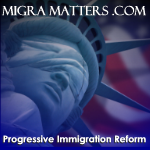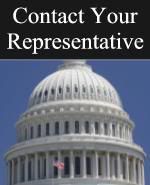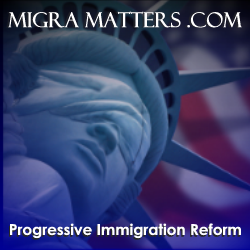New report from CRS casts doubts on immigration restrictionists claims.
 One often wonders when listening to various politicians pontificate about immigration reform, exactly what information they are basing their policies and positions on. Given the conflicting information coming from both partisan and academic sources, it would appear a daunting task to get reliable, non-biased information about the issue. A recently released report from the Congressional Research Service provides a unique glimpse into what our legislators are reading about the issue. "Unauthorized Aliens in the United States: Estimates Since 1986", compiled by the legislative branch's own research agency, not only looks at the increase in unauthorized migration during the period between 1986 and 2004, but analyzes some of the reasons for it.
One often wonders when listening to various politicians pontificate about immigration reform, exactly what information they are basing their policies and positions on. Given the conflicting information coming from both partisan and academic sources, it would appear a daunting task to get reliable, non-biased information about the issue. A recently released report from the Congressional Research Service provides a unique glimpse into what our legislators are reading about the issue. "Unauthorized Aliens in the United States: Estimates Since 1986", compiled by the legislative branch's own research agency, not only looks at the increase in unauthorized migration during the period between 1986 and 2004, but analyzes some of the reasons for it.
Additionally, the report critiques some immigration policies, past, present and proposed, to determine their effectiveness. Not surprisingly, some of the most often advocated policies have failed in the past and show no sign of succeeding in the future.
So why do certain politicians continue to advocate for them?
In recent months, at the urging of immigration restrictionists, the administration has launched a series of workplace raids leading to numerous arrests and deportations. The rationale behind the crack-down being that the ready availability of jobs and employers willing to skirt the law, are major factors in drawing undocumented immigrants to the US. But the CRS finds that this theory is hard to backup with any hard empirical data. The research points to a constellation of factors that have contributed to the increase in unauthorized resident aliens. Historically, unauthorized migration is generally attributed to the “push-pull” of prosperity-fueled job opportunities in the United States in contrast to limited or nonexistent job opportunities in the sending countries. Some observers maintain that lax enforcement of employer sanctions for hiring unauthorized aliens has facilitated this “push-pull,” but it is difficult to empirically demonstrate this element. Political instability or civil unrest at home is another element that traditionally has induced people to risk unauthorized migration, but the motives for such migrations are sometimes mixed with the economic hardships that are often correlated with political upheaval.
CRS also looks at the cornerstone of immigration restrictionist policy; tighter border control. With constant calls for increased spending on enforcement, the building of walls, and militarization of the border, the CRS found that contrary to stemming the tide of undocumented migrants, these policies have in fact increased the population of unauthorized residents.Although most policy makers have assumed that tighter border enforcement would reduce unauthorized migration, some researchers are now suggesting that the strengthening of the immigration enforcement provisions, most notably by the enactment of the Illegal Immigration Reform and Immigrant Responsibility Act of 1996 (IIRIRA), may have inadvertently increased the population of unauthorized resident aliens. This perspective argues that IIRIRA’s increased penalties for illegal entry coupled with increased resources for border enforcement stymied what had been a rather fluid movement of migratory workers along the southern border; this in turn raised the stakes in crossing the border illegally and created an incentive for those who succeed in entering the United States to stay.
The report notes that the number of unauthorized residents remained relatively flat during the first ten years following the passage of the Immigration Reform and Control Act (IRCA) of 1986. Except for a dip to 1.9 million immediately following IRCA's legalization program, the number hovered at a little under 3.5 million until the stricter enforcement measures of the IIRIRA were implemented in 1996. Since then the numbers have only continued to climb.
(Editors note: It's interesting to note that although not mentioned in the report, the increase also coincides with the enactment of NAFTA)
Many of the restrictionists other assertions, mainly those revolving around a lack of enforcement, often claimed to be contributing factors to increased numbers of unauthorized residents are deemed "elusive factors" that are difficult to measure and prove.Some observers point to more elusive factors — such as shifts in immigration enforcement priorities away from illegal entry to removing suspected terrorists and criminal aliens or discussions of possible “amnesty” legislation — when they assess the increase of unauthorized resident aliens. Others argue that border security measures enacted in recent years have not received adequate funding to be effective against unauthorized migration, and some maintain that state and local law enforcement officers have not been sufficiently involved in apprehending illegal aliens. Some would make illegal presence an aggravated felony. Still others assert that there has not been sufficient funding and staffing for enforcement of immigration laws in the interior of the country. It is difficult to measure whether, or to what extent, these other phenomena have contributed to the increase in unauthorized resident aliens
The report also examines a factor that has led to increasing numbers of unauthorized residents that's rarely discussed by politicians and pundits: The glaring flaws in the way the immigration system is administered.Another contributing factor — best represented by the “quasi-legal” aliens discussed above — is the wait-times for immigrant petitions to be processed and visas to become available to legally come to the United States. There are statutory ceilings that limit the number of immigrant visas issued each year. There are also significant backlogs in processing petitions due to the high volume of aliens eligible to immigrate to the United States and the large number eligible to become U.S. citizens. Of the pending cases, reportedly almost 2 million are immediate relative and family preference petitions. Many observe that these family members sometimes risk residing without legal status with their family in the United States while they wait for the petitions to be processed or visas to become available.
These findings come not from a partisan think tank or advocacy group, but rather the agency tasked by congress to gather unbiased information for the purpose of enacting informed legislation. The CRS website explains their mission: The Congressional Research Service is the public policy research arm of the United States Congress. As a legislative branch agency within the Library of Congress, CRS works exclusively and directly for Members of Congress, their Committees and staff on a confidential, nonpartisan basis.
History and Mission
Congress created CRS in order to have its own source of nonpartisan, objective analysis and research on all legislative issues. Indeed, the sole mission of CRS is to serve the United States Congress. CRS has been carrying out this mission since 1914, when it was first established as the Legislative Reference Service. Renamed the Congressional Research Service by the Legislative Reorganization Act of 1970, CRS is committed to providing the Congress, throughout the legislative process, comprehensive and reliable analysis, research and information services that are timely, objective, nonpartisan, and confidential, thereby contributing to an informed national legislature.
CRS
Given that tax payers dollars are spent to provide Congress with reliable and non-partisan information on the pressing issues of the day in hopes that legislators make informed and knowledgeable decisions regarding public policy, why is it that so many of our current legislators chose to ignore their own research in favor of flawed and biased information that will certainly lead to unsound policies doomed to fail before even enacted? Mr. Tancredo…are you listening?
tags: immigration, CRS , reports, effects of immigration

































No comments:
Post a Comment